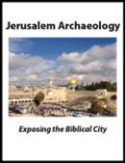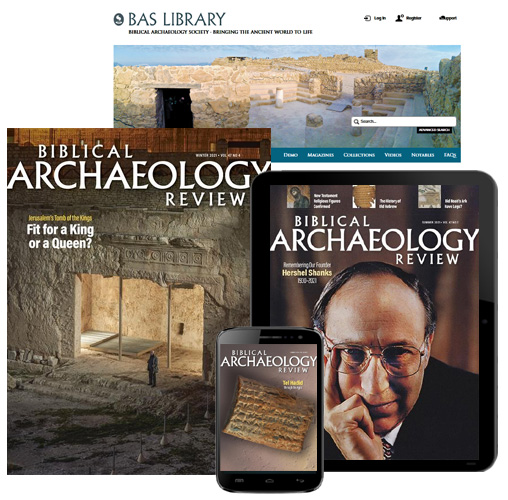Tel Be’er Sheva, City of the Patriarchs
Site seeing in the capital of the Negev Desert
Known today as Tel Be’er Sheva, biblical Be’er Sheva sits in the northern Negev Desert, a few miles away from the modern city of the same name. Although far from the powerful cities of Jerusalem and Lachish, Be’er Sheva played an important role in the biblical narrative, especially the stories from the time of the Patriarchs. Be’er Sheva is mentioned 33 times in the Hebrew Bible. As told in Genesis, Be’er Sheva was home to Abraham, Isaac, and Jacob. It was there that Abraham formed a covenant with King Abimelech (Genesis 21:32) and also where both Isaac and Jacob spoke to God (Genesis 26:23–24; 46:1–4). Tel Be’er Sheva also played an important role in the Judahite state under David and his descendants. It functioned as the southern border of Judah (Judges 20:1) and was an important administrative center in the Negev. Excavations have uncovered numerous fascinating finds at Tel Be’er Sheva, including the Iron Age city of the Davidic monarchy and a remarkable horned altar, nearly identical to the Israelite altars often mentioned in the Hebrew Bible (Exodus 30:2). With its many biblical connections, Tel Be’er Sheva is certainly one of the most interesting biblical sites in the whole Negev.

View of the southeastern side of Tel Be’er Sheva, including the four-chamber gate, city square, governor’s palace, and more.
Credit: Photo Courtesy Nathan Steinmeyer.
Excavations were carried out at Tel Be’er Sheva from 1969 to 1976 by Tel Aviv University under the direction of Yohanan Aharoni and Ze’ev Herzog. The excavation uncovered an incredibly well-constructed and planned Iron Age city. The earliest definitive strata uncovered at Tel Be’er Sheva date no earlier than the Iron Age I (c. 1200–1000 B.C.E.), hundreds of years after the period of the Patriarchs. Numerous suggestions have been presented as to how to explain this lack of evidence of earlier settlement. Given that the Iron Age city was constructed atop the natural bedrock, it may be that the city’s construction eradicated any earlier remains. A few finds from the Chalcolithic Period (c. 4300–3300 B.C.E.) have been found, although no architectural features were discovered, possibly due to the later stages of development.

Iron Age Fortifications at Tel Be’er Sheva
Tel Be’er Sheva was only a small rural settlement in the early Iron Age, reaching a population of around 100 people during the tenth century. Ze’ev Herzog suggested in “Beer-sheba of the Patriarchs” in the November/December 1980 Issue of Biblical Archaeology Review that Saul likely built up the town during his war with the Amalekites (1 Samuel 15). At the very end of the tenth century, or early in the ninth century, a concerted effort was made to establish the settlement as a major city. At this time, a large, 13-feet thick wall was built around the tell, as well as a defensive glacis. This would likely have been after the fall of the United Monarchy, as there are no archaeological or literary signs that Be’er Sheva fell victim to <Shishak’s famous campaign

The reconstructed remains of the four-chamber gate at Tel Be’er Sheva.
Credit: Photo Courtesy Nathan Steinmeyer.
In the eighth century, following a destruction possibly caused by the earthquake mentioned in Amos 1:1, the city’s solid wall was replaced with a casemate wall. This new wall included an elaborate four-chamber gate.

Close look at the interior of Tel Be’er Sheva’s four-chamber gate.
Credit: Photo Courtesy Nathan Steinmeyer.
Tel Be’er Sheva, Capital of the Negev
From the ninth century until its destruction by Sennacherib in 701 B.C.E., Be’er Sheva functioned as the main administrative center of the Negev Desert. Indeed, for much of this period, Be’er Sheva was the only major Judahite city in the Negev. In addition to a large administrative structure, dubbed the “Governor’s Palace,” three large storehouses were constructed next to the gate complex. The storehouse complex covers roughly 6,500 square feet, with each storehouse featuring two rows of stone pillars. Hundreds of vessels were uncovered in the storehouses, showing their use in gathering oils, grains, and other products from the smaller villages of the region. These storehouses were possibly constructed by King Hezekiah in the late eighth century in preparation for Judah’s conflict with the Neo-Assyrian Empire.

One of three pillared storehouses constructed in Tel Be’er Sheva during the eighth century B.C.E.
Credit: Photo Courtesy Nathan Steinmeyer.

Close-up view of the pillar bases of one of Tel Be’er Sheva’s storehouses.
Credit: Photo Courtesy Nathan Steinmeyer.
The Altar of Tel Be’er Sheva
Built into the wall of one of the storehouses was one of the most interesting finds discovered in Tel Be’er Sheva, a horned altar. The altar had been dismantled and used as building material in the wall of the storehouse. The altar was reconstructed at three cubits high (5.25 feet) and closely matches the description of such altars given in the Hebrew Bible (Exodus 30:2). The altar shows that the city once held a cultic structure, possibly dedicated to the Israelite God Yahweh, like the temple discovered in nearby Arad.

Reconstruction of the altar discovered at Tel Be’er Sheva, now held in the Israel Museum in Jerusalem.
Credit: Photo courtesy Tamarah, CC BY-SA 3.0, via Wikimedia Commons
The dismantling of the altar has been linked by many to the religious reforms of King Hezekiah (2 Kings 18:1–4). However, the exact nature of this altar and its connection to the biblical story have been hotly debated in the pages of Biblical Archaeology Review. The famous Israeli archaeologist Yigael Yadin suggested that the altar could be the one mentioned by name in 2 Kings 23:8 as having been destroyed not by Hezekiah, but by Josiah. This would completely alter the dating of the site, establishing its final destruction as coming by the hands of the Babylonians in 586 B.C.E. However, this view was strongly opposed by others, with most scholars now agreeing that the altar was destroyed in the time of Hezekiah.
The Intricate Planning of Tel Be’er Sheva

View of Tel Be’er Sheva with the four-chamber gate and the city square on the left and roads that show clear evidence of cityplanning.
Credit: Photo Courtesy Nathan Steinmeyer.
Be’er Sheva was also an incredibly well planned city. The city includes a belt of houses running along the casemate wall with a 6-foot-wide peripheral street running parallel to the walls. Additional streets radiated through the city in straight lines to provide a high degree of organization and movability. The city also included a covered drainage ditch, a large city square, and a complex water system. The excavators suggested that Be’er Sheva was built as a planned city, in which the earlier town was actively dismantled and the later Iron Age city constructed according to a preconceived plan at a single time.

The peripheral street, running parallel to the city walls.
Credit: Photo Courtesy Nathan Steinmeyer.
As part of the city’s fortifications, a large and complex water system was also built into the hillside and was meant to provide water even in times of siege. The system included a 56-foot deep shaft and a large reservoir capable of holding 185,000 gallons of water.

Artist’s rendering of Tel Be’er Sheva’s water system, located at the site.
Credit: Photo Courtesy Nathan Steinmeyer.

The descent into Tel Be’er Sheva’s water system, with a flight of stone steps along the side.
Credit: Photo Courtesy Nathan Steinmeyer.
Although no evidence from the period of the Patriarchs has been found at Tel Be’er Sheva, its exquisite construction—and remarkable modern reconstruction—make it one of the most interesting archaeological sites in Israel, and certainly a spectacular under-the-radar tourist spot.
Read more in Bible History Daily:
Jewish City Discovered Near Be’er Sheva
All-Access members, read more in the BAS Library:
Horned Altar for Animal Sacrifice Unearthed at Beer-Sheva
Beer-Sheva Excavator Blasts Yadin—No Bama at Beer-Sheva
Yadin Answers Beer-Sheva Excavator—Reply to Rainey’s “No Bama at Beer-Sheva”
Not a BAS Library or All-Access Member yet? Join today.Must-Read Free eBooks
Want more Bible history?
Sign up to receive our email newsletter and never miss an update.
All-Access Pass
Dig into the world of Bible history with a BAS All-Access membership. Biblical Archaeology Review in print. AND online access to the treasure trove of articles, books, and videos of the BAS Library. AND free Scholar Series lectures online. AND member discounts for BAS travel and live online events.
Subscribe Today












Is it possible that the lack of remains from the Patriarchal period is due to the use of non-masonry building materials? Such materials would most likely have disintegrated or been used up by the time of the first Iron Age masonry structures.
During the 9th through 7th Centuries BCE, the name of Be’er Sheva would have been pronounced Biʾr šabʿ not Bəʾēr šeḇaʿ. Why do we insist on using (anachronistic 9th century CE) medieval pronunciations of places to describe Late Iron Age dwellings? Also, Negev would have been Nagb.
If we are going to delve into peeling back the archaeology of the period, we owe it to the reader to use the correct language that would have been contemporary with the subject. Otherwise, readers will get the impression that those people spoke the same type of Hebrew as modern Israelis that is obviously not the case.
Thanks for an otherwise educational article.
Thank you very much for your comment. Unfortunately, when dealing with names, words, or languages that are thousands of years old, it is almost impossible to know the exact pronunciations. Additionally, it is common practice to stick to a single pronunciation within a work in order to maintain clarityy. For these reasons, as well as various stylistic reasons, we tend to use modern pronunciations. This likewise is beneficial for people that are not familiar with the languages to better follow and understand.